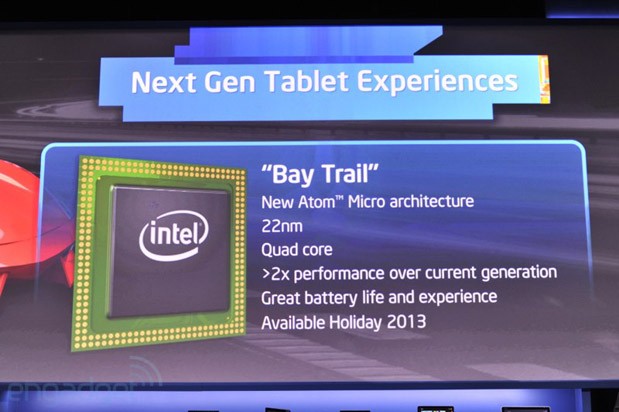Intel Announces Atom Bay Trail Processor For Tablets
Intel has announced new Bay Trail Atom processors for tablets, as well as the 'Lexington' processor for smartphones.
The new Bay Trail Atom system-on-a-chip processors are quad-core and are notably smaller than previous Atoms thanks to a new 22nm design. They boast better "all-day" battery life and greater processing power, which is apparently twice as fast as current Atoms. Quad-core Bay Trail Atoms is currently scheduled for a launch by holiday 2013.
For worldwide markets and budget phones, Intel announced the development of another Atom processor, the 'Lexington'. Intel also announced a smartphone for emerging markets that will sport the Lexington Atom Z2420 w/XMM 6265 chip. The chips are designed for markets including Africa, China, Latin America and Southeast Asia.
The chips boasts speeds of up to 1.2GHz with Hyper-Threading, HD video encoding and decoding (1080p 30fps), camera support with seven-frame burst mode, as well as SGX540 graphics. FM radio, microSD card slot and Intel Wireless Display for playback on TVs are also included.
Contact Us for News Tips, Corrections and Feedback
Get Tom's Hardware's best news and in-depth reviews, straight to your inbox.

Zak Islam is a freelance writer focusing on security, networking, and general computing. His work also appears at Digital Trends and Tom's Guide.
-
Cazalan I was expecting more than 2x with twice the cores. They must have had to scale back the clocks to get that many cores in.Reply -
joytech22 SGX540 Graphics..? Great. So they are using generations-old PowerVR technology when something like the SGX543 MP4 could have performed quite well with good battery life.Reply
In other words, they are using the same GPU as my old now defunct Galaxy S. -
Daedalus12 Holiday 2013? Seems like a long way off.Reply
Even with Medfield, Intel is virtually a non player in the phone space right now. I would have expected them to leverage their 22nm process for mobile SoC's well before then. Unless they have some other great SoC's coming out soon, it seems like they are wasting time. -
robholden Daedalus12Holiday 2013? Seems like a long way off. Even with Medfield, Intel is virtually a non player in the phone space right now. I would have expected them to leverage their 22nm process for mobile SoC's well before then. Unless they have some other great SoC's coming out soon, it seems like they are wasting time.Reply
bay trail is a tablet solution (update to the currently shipping clovertrail), not a phone solution, so not sure why you bought medfield in to this... It has full x86 functionality... (although don't bother trying to run anything needing any real power...) -
InvalidError Daedalus12Unless they have some other great SoC's coming out soon, it seems like they are wasting time.Intel is still a relatively new player in the SoC market. The first generations of Atoms were not particularly successful but Intel is getting pretty serious about it. The newest Atoms manage to beat some of the newest ARM chips in many benchmarks on both power and performance. I wasn't expecting that considering how much legacy crud x86 CPUs have to waste power on.Reply
Seems like Intel already has some quite decent SoCs, albeit possibly not for 3D mobile gaming. -
g00fysmiley intel seems to have some nice soc and low power designs its a sham we don't see em in many products i would love an x86 reasonably priced tablet competing with armReply -
deksman CazalanI was expecting more than 2x with twice the cores. They must have had to scale back the clocks to get that many cores in.Reply
Scaling back core clocks has little to do with how many cores they can cram on a die - it has more to do with power consumption and heat generation.
Also... the article is rather vague on performance.
Is the 2x performance increase due to the architecture only, or is it because of both architecture and added cores?
If its the former, then you would basically see 2x higher performance due to architecture clock per clock on a single core, and then add 3 more cores to the mix.
If its the latter, then Intel either had to scale back the individual core clocks due to power/thermal constraints.
Reducing the die itself to 22nm (using Silicon - which is SORELY outdated for computer chips) also means cramming more transistors into a smaller area - that alone will create higher thermal footprint (so in this case, using Silicon, the lower you go, the hotter it will get, and Intel will have to continuously make various cutbacks if they insist on using Silicon - which is probably what they will do until they milk it dry - nevermind that we had the ability to use far superior synthetic materials and methods of production for computer construction a long time ago, that would in turn make computers of today look like they were 60 to 100 years old - which they are, seeing how our scientific knowledge and practical application of it is basically by that much ahead of anything we presently use).
-
ginghus_khan2000 What is up with Intel their blindness to video performance? I suppose from their perspective 90% of users don't care but.... jeez! Why bother with crazy fast processors and crappy video cards? Over and over.Reply -
I think people are way off on what they are saying. Intel's new architecture is supposed to be out of order, along with die shrink, along with new baseband technology, etc. It is a completely different architecture and not something you can do in a short period of time. I don't know wht the vague 2x number means. It could mean 2x the performance per core which is believable considering the improvement in architecture. I doubt it is 2x the performance over a chip with 1/2 the cores. They could do that right now with Atom while not changing the architecture. Intel previously said they will reduce power with this new architecture even with more cores and better graphics. Supposedly, they are moving to a new graphics architecture on the Tablet side (same as Haswell). That is a lot of change for 1 cycle. I would be surprised if they get this out by next holiday season.Reply
